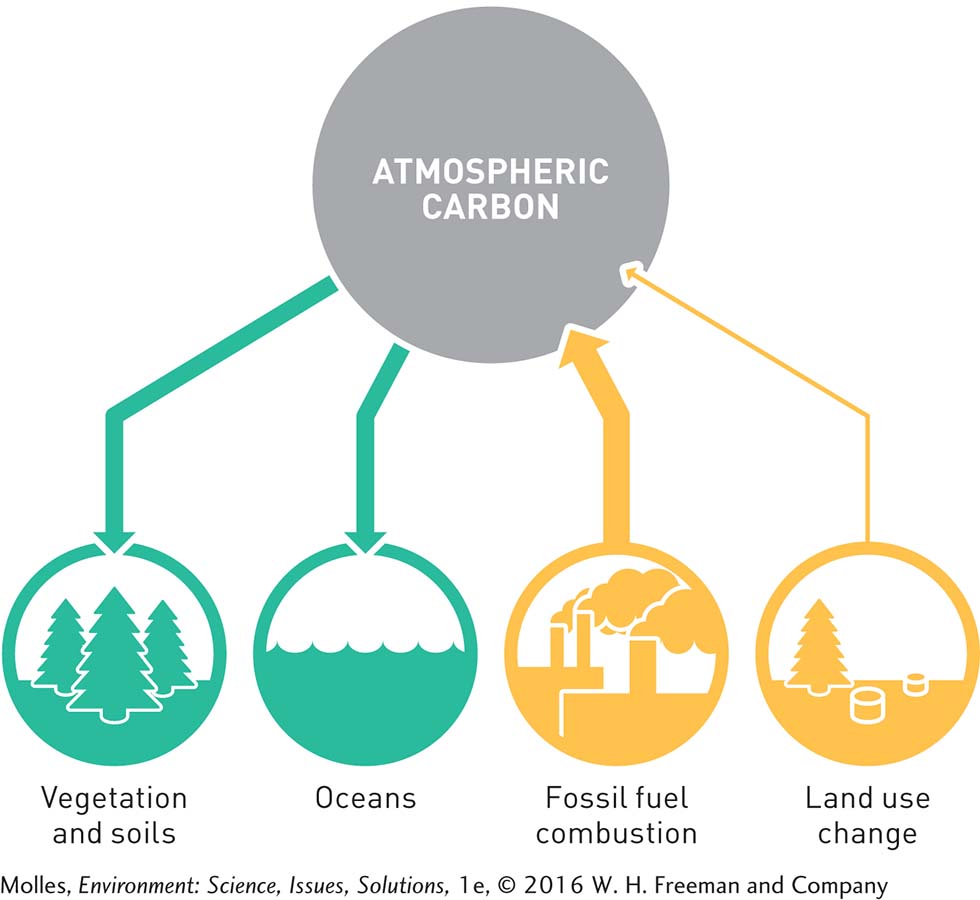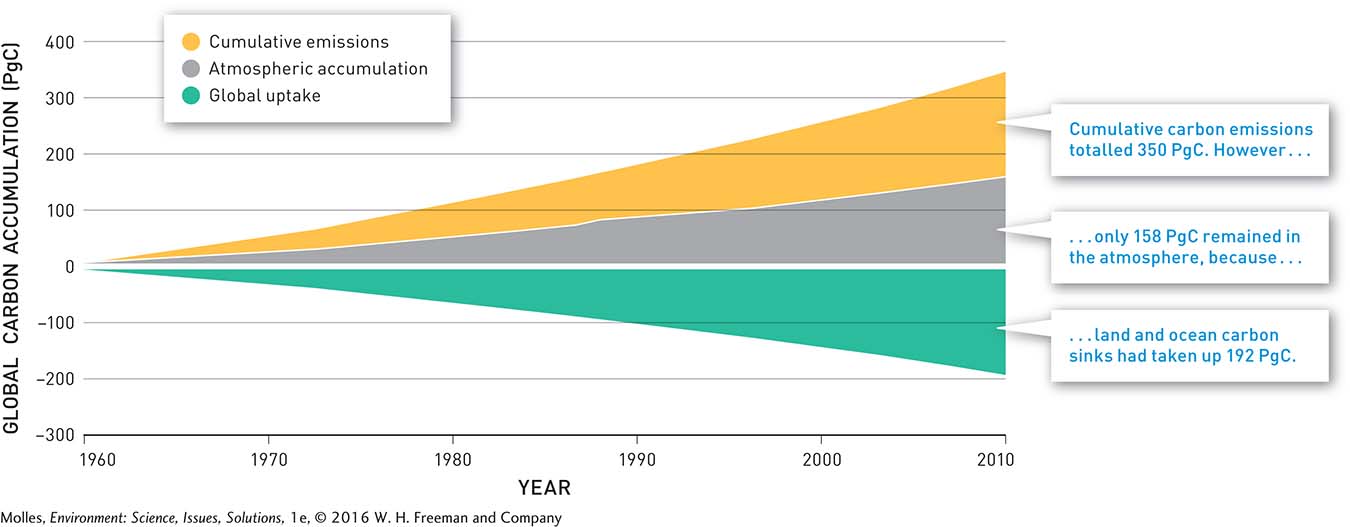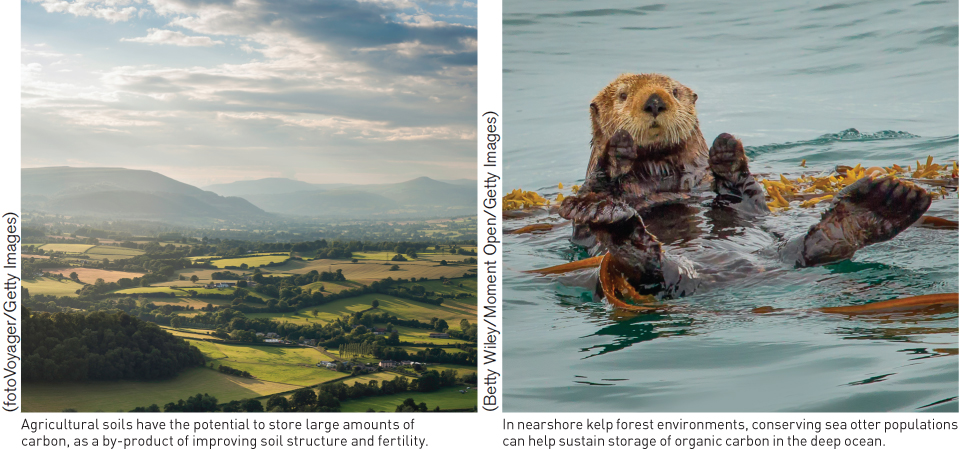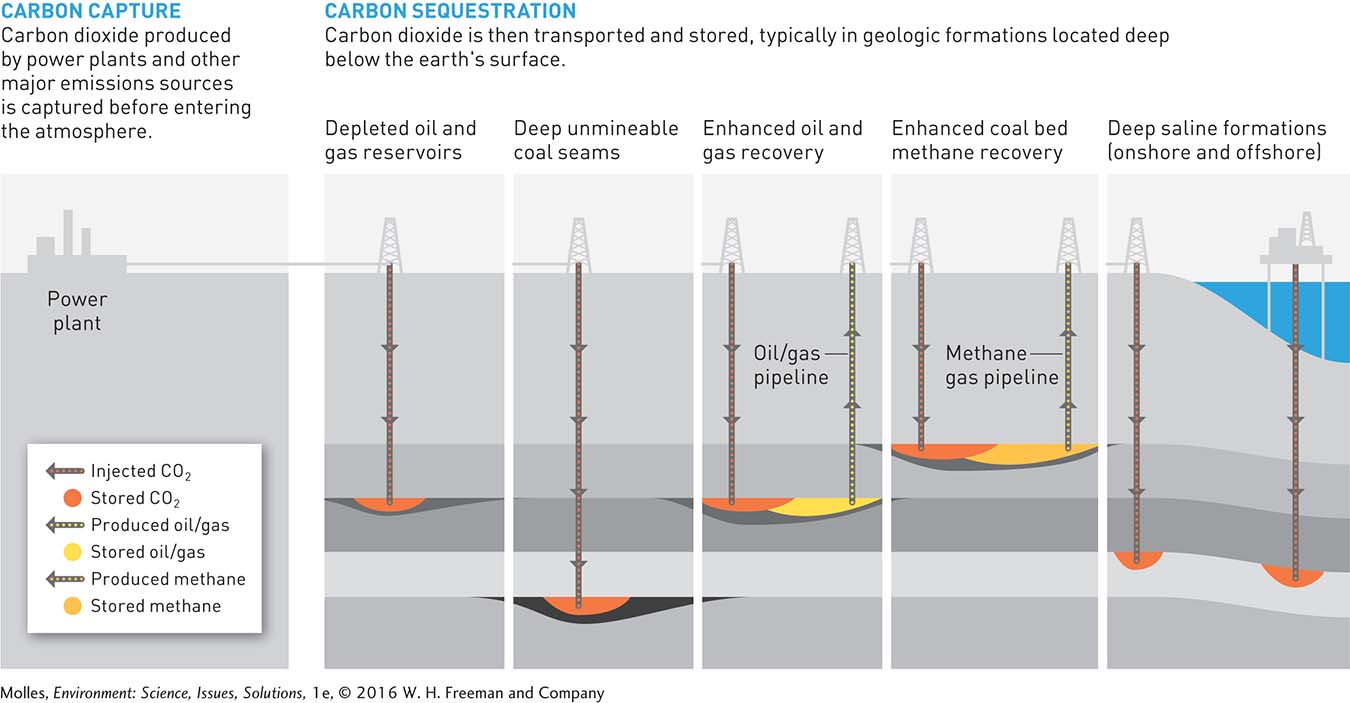14.11 Restoring and enhancing carbon sinks could help balance the carbon budget
Reducing greenhouse gas emissions from fossil fuels is currently the number one challenge to mitigating climate change, but we can also remove carbon dioxide that’s already in the atmosphere through natural and technological solutions.
carbon sink A part of the Earth system that takes carbon compounds from the atmosphere, through biological or physical processes, and removes them from active circulation.
As limestone rocks and coral reefs form, they naturally pull carbon dioxide out of the air and lock up the carbon in a stony matrix. As forests photosynthesize sunlight, they draw in carbon dioxide from the air and store it in biomass. We call these carbon sinks because they are parts of the Earth system that take carbon compounds from the atmosphere, through biological or physical processes, and remove them from active circulation (Figure 14.39). Other natural carbon sinks include dissolved carbon dioxide in deep ocean water and carbon-

Carbon Uptake by Land and Oceans
In theory, calculating the global scale of Earth’s carbon sinks should be a simple matter of arithmetic. First, we estimate how much CO2 is emitted into the atmosphere by measuring fossil fuel burning, deforestation, and other sources of emissions. Then we independently measure the amount of carbon dioxide added to the atmosphere from one year to the next using sensors. The difference between the emission estimate and the atmospheric measurement gives us an estimate of our global carbon sink.
Obtaining all the numbers for the carbon sink calculation requires a variety of assumptions, but in August 2012 a group of researchers published a study in Nature trying to do just that. They discovered some good news: The uptake of carbon dioxide by land and ocean carbon sinks has doubled over the 50-

It’s not entirely clear why these carbon sinks have grown, and there are no guarantees that these increases in uptake will continue. If our carbon sinks become saturated, more of the carbon dioxide we emit will end up in the atmosphere, contributing to further warming. It’s also important to note that we still can’t tell how much of the growth in the carbon sink is due to forests and other terrestrial ecosystems versus marine ecosystems, but such studies will help us focus our carbon mitigation efforts in the right places.
Agriculture, Forestry, and Conservation
Cutting down forests and replacing them with agriculture releases a large amount of carbon dioxide into the atmosphere. In developing countries such as Indonesia and Belize, land use change, largely deforestation, represents a significant fraction of their greenhouse gas emissions. The opposite is also true. In forests, the amount of carbon in storage increases as they mature. In the United States during the last 20 years, the amount of carbon dioxide taken up by forests has increased 20%.
However, carbon does not only accumulate above ground but also, and perhaps more reliably, in soils both in forests and on farmland. Certain agricultural practices can sustain soils as carbon sinks, increasing soil health and fertility (see Figure 14.41). We have already discussed some of these practices in Chapter 7, where we reviewed no-
Although it may be obvious that leaving a forest or wetland intact keeps carbon dioxide from entering the atmosphere, predators such as wolves and lions also have a role to play in maintaining our carbon sinks. When gray wolves were reintroduced to Yellowstone National Park in 1995, they preyed on and reduced the number of large herbivores in the ecosystem, including deer and elk. With fewer elk on the landscape, more willow, cottonwood, and aspen are growing to full size, potentially increasing carbon storage in the landscape (see Figure 4.16, page 108). A positive effect by a predator on plants is called a trophic cascade. Unexpectedly, the reintroduction of wolves also boosted beaver numbers, from a single colony in 2001 to nine colonies in 2011. Beavers depend on willows to survive the winter, and their dams create marshes and ponds that act as carbon sinks.
Trophic cascades are not limited to terrestrial ecosystems, however. Recent studies of sea otters have shown that their presence can increase the potential of kelp forests to act as carbon sinks by an estimated 10 times (Figure 14.41).

Carbon Capture and Sequestration
carbon capture and sequestration A technological strategy to reduce additions of carbon dioxide and other greenhouse gases to the atmosphere by collecting them at the point of emission and storing them in a place or chemical form that removes them from active circulation in the carbon cycle.
In San Antonio, Texas, a revolutionary “Skymine” opened in October 2014. The portable Skymine in San Antonio is attached to a cement factory, but it can attach to other facilities such as a power station or factory, capturing carbon dioxide emissions and transforming them into baking soda, which can be used to make paper or cement. Mineralization is just one new technology for preventing carbon dioxide from entering the atmosphere, part of a broader strategy called carbon capture and sequestration (Figure 14.42).

The IPCC has estimated that carbon capture and sequestration could reduce emissions from conventional power plants by 80% to 90%, providing a significant boost to carbon reduction goals. These technologies face a common roadblock, though: where to store the gas and how to do it without burning more fossil fuels in the process. Some scientists have proposed pumping carbon dioxide to the bottom of the ocean, but such an approach has been ruled out because it would increase ocean acidification.
geo-
gasification A technique to make carbon capture at coal-
Geo-
Geoengineering
geoengineering Proposed technological approaches to manipulating processes that influence climate, such as carbon dioxide uptake by marine algae, in an effort to mitigate global climate change.
In February 2004 a marine biologist named Victor Smetacek dumped several tons of iron sulfate into the Southern Ocean as part of the European Iron Fertilization Experiment. Because plankton growth depends on the availability of iron, Smetacek’s goal was to spawn a plankton bloom by providing an influx of iron, which could potentially pull carbon dioxide out of the atmosphere. His results, published in Nature in 2012, demonstrated that when shelled plankton called diatoms die, they sink deep in the water column and sequester carbon in the process. This radical approach, dubbed geoengineering, seeks to “hack” the Earth system in order to reduce global temperatures.
Despite this early success, scientists remain skeptical of iron fertilization because of the damage it could cause the ecosystem as a whole, and the slim likelihood that it would be successful. For instance, there’s no way to control which type of algae will bloom, and the approach could backfire by producing toxic algae. Such blooms could also lead to the depletion of oxygen in oceanic waters and cause an imbalance in marine ecosystems. Finally, the approach is a stopgap measure and will only trap carbon for a few centuries. In 2007, 35 countries that are party to the London Convention, which regulates ocean pollution, agreed to a moratorium on ocean fertilization.
More generally, geoengineering has produced some of the most controversial ideas to combat climate change, which go beyond considering just boosting carbon sinks or reducing carbon emissions. Some thinkers have proposed placing 15 trillion mirrors in orbit to reflect the Sun’s rays. Others have suggested adding sulfur to the atmosphere or spraying seawater into the air to create clouds and thus reflect more sunlight away from Earth’s surface and back into space.
Many of these ideas have been dismissed as being too expensive, far-
Adapting to Climate Change
climate adaptation A strategy to reduce the impacts and hazards associated with climate change.
In the end, it is already too late to head off climate change completely, and societies must be prepared to cope with its impacts. The IPCC has noted that climate adaptation, which is a strategy to reduce the impacts and hazards associated with climate change, must go hand-
For instance, rising sea levels will make coastal areas more susceptible to storm surges, which means nations, regional governments, and cities need to develop plans for what areas to protect and what areas to retreat from. In densely populated areas with critical infrastructure, such as lower Manhattan, cities may need to bolster flood protections with seawalls and hurricane barriers. In less populated areas where seawalls are not feasible, current homeowners could be encouraged to reinforce existing homes or elevate them off the ground. At the same time, communities should not permit new buildings in areas that will be prone to coastal storm surges in the future. Other aspects of our infrastructure, including sewage systems and power plants, should be designed to withstand flooding and other extreme weather events.
Farmers will also have to adapt to a warmer world. Scientists are already working to develop both drought-
The IPCC expects the cost of adaptation to continue to grow over the next century, and not all regions or countries will be impacted in the same way by climate change. Poorer countries are the ones expected to be most impacted by climate change, and they will require assistance from richer, industrialized nations. Undoubtedly, the Earth is going to be a very different place in the year 2100. Are we going to be ready?
Think About It
Which ecosystems that can act as natural carbon sinks should we consider managing in order to increase their rates of carbon storage for climate mitigation?
What is the wildest geoengineering project you can imagine to reduce global temperatures? How might it cause problems in the future?
How would you prepare your own home for climate change?
14.9–14.11 Solutions: Summary
Mitigating climate change requires reducing greenhouse gas emissions, primarily from electricity generation and transportation. Trading fossil fuels with large carbon footprints for fuels with smaller footprints, along with renewable energy sources, is a first step. Fuel-
Reducing greenhouse gas emissions will result in significant costs for some companies and profits for others, while jobs may shift from one sector to another. Entrepreneurs are capitalizing on new opportunities by designing efficient, electric vehicles and more efficient architecture. In developing countries, companies have begun selling more efficient wood-
We can increase the uptake of greenhouse gases through carbon sinks. Agricultural soils and natural ecosystems alike can be managed to act as significant carbon sinks. Carbon capture and sequestration have the potential to reduce the rate at which electrical generation emits CO2 to the atmosphere. Geoengineering is a radical approach to alter Earth’s climate, which should only be pursued cautiously.
Societies will need climate adaptation strategies to cope with the impacts of sea level rise and the increased frequency of extreme weather events.